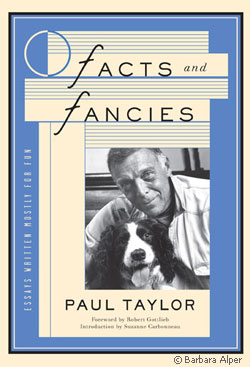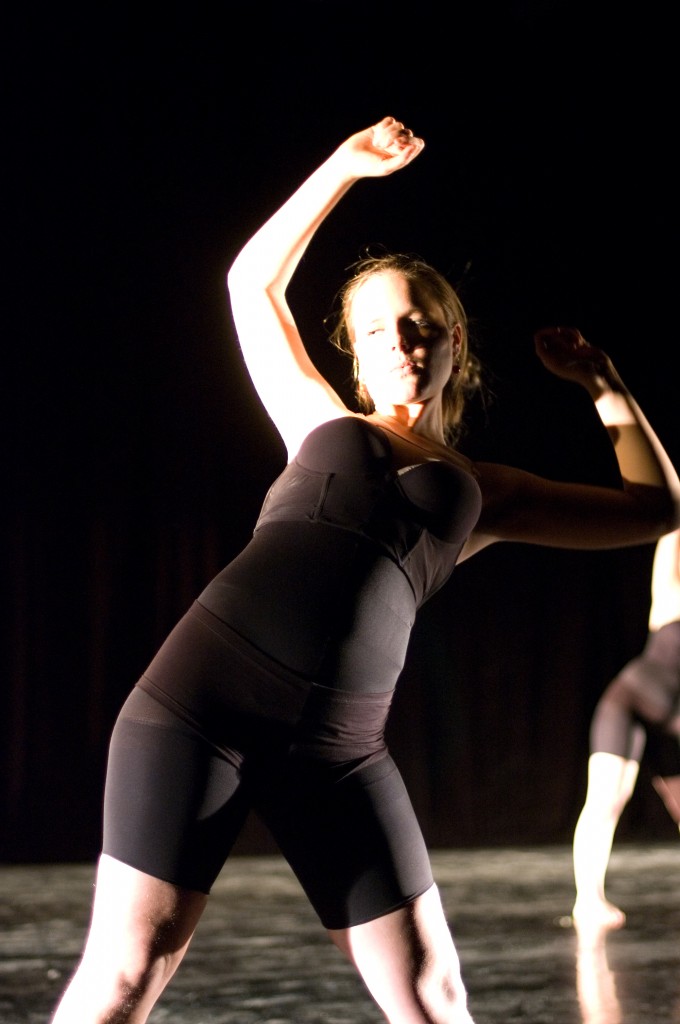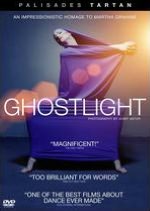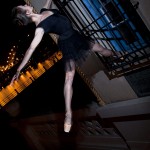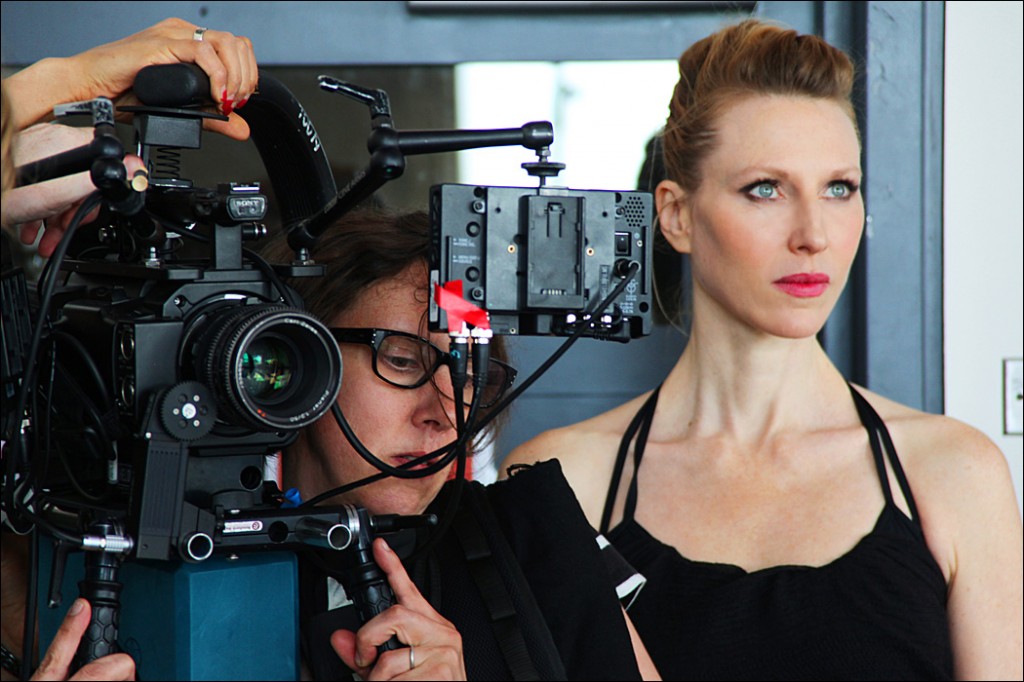
The other day we reviewed “Fall To Rise” and posted the preview for this dance-themed movie on the site. Today we have dancer/actress Katherine Crockett with us to talk a little bit about her role in the movie…
Even though your role in Fall To Rise is that of a dancer, it is really an acting role. Can you talk a little about the differences and similarities in preparing for a performance in dance as compared to getting ready to play a character in a movie?
In many ways it is very similar, in that you need to be able to let go and become the character you are playing, you must do research on your character and rehearse whether it’s rehearsing movement or words it is the same, the goal is to integrate the form so deeply and find the instinct behind the form (the movement or words) that will give you a personal connection and meaning when you perform it for an audience of the camera or the theater.
The action, whether acting or dancing, should feel organic and come from a place of intimate truth from within, that can only be arrived at through deep study of the character and the material (script/choreography) you wish to bring to life. Coming from Martha Graham’s world which has been my main background, her work demands that you dig into your own being and the character beyond what is even happening on stage. She said, “when dancing Medea, I knew her so well I even know what she had for breakfast!” When you walk onstage you don’t just walk onstage, you must know where you are walking in from, and carry that history with every step you take.
In acting it is the same, you have your own inner subtext, you have personal connections and associations with very specific details of your character and these may or may not be revealed through the action or script, but serve as an inner life that fills the action and even the stillness that one carries forth. So the preparation involves exploring every avenue to embody this character you are about to inhabit, you must become possessed by her, again to quote Martha Graham, “There is a moment when you look in the mirror and she looks back at you and recognizes herself in you.” You must find this connection first by looking at yourself, and how you can connect to this character on the deepest most primal level, and I believe some of the smallest details hold a particular link to finding these connections. Being a dancer, I’m highly sensitive to my body and know how to use the power of nonverbal communication, so my challenge was how to have that same organic flow and ease with words.
For me, the preparation for this role was a similar process to my preparations for other dance roles. What was more of a difference was how your character comes into play with the other characters during the process of shooting or performing. It is not just about acting, but for me, almost more about reacting to your fellow actors. Like in life, you don’t now what is going to happen next, so there needs to be the same unknowing, for me that meant really listening, really being in the moment, and then letting my reactions and my words come from that impulse, even though the words themselves are of course scripted and rehearsed.
Performing a dance has this same quality of reacting and responding to your fellow dancers, but the difference I felt was that in shooting, because there were several takes of a scene, I could try several different ways of communicating the same lines, or actions, and my co-stars would do the same which would then necessitate my own actions/reactions to change on the spot. It really puts you in the moment, you are not performing any virtuosic, spectacle, you are being present, you are being open and vulnerable, you can’t worry about how you look, because that will take you away from your emotional connection of the moment. Sometimes, we had to shoot an emotionally difficult scene over and over, and you really have to keep yourself connected to your character and the moment, or you will have nothing. There is a sensitivity to subtlety in your expression that is really important. The camera catches every detail, so unlike the stage where some things have to be exaggerated, in film, much of the power comes in the subtle movements and expressions.
Are any of your character’s struggles things that you have had to deal with in your own dance career?
Well, I don’t have a child, so that major struggle that my character is dealing with, I don’t have. But what I relate to and every dancer understands, is how after living a life as a professional dancer for a significant amount of years, your identity is absolutely linked to that. I’ve struggled with injuries that put me out for a year twice in my career, and I felt so lost, and depressed during that time. Dance, for me, is the heightened sensation of life moving through me, performing is an adrenaline rush, and the years of practice and dedication to your craft can finally be the means to which you can express your soul. Without that, you feel empty. It exists only in the moment, there is no product, nothing to hold or show after, it only exits the moment that it is lived. And by it’s very nature, of the instrument being the human body itself, it is a career, that has an early death.
Martha Graham said ” A dancer dies 2 deaths, the first one is when she can no longer dance.” I’ve been at this career my whole life, and my body has been through a lot, and I am terrified for the day that I can’t dance as fully as I want. I see things that already have shifted. Aging as a dancer is painful, emotionally and physically as well. The dance world is a ageist world, where youth is glorified, the extreme exaggeration of what our culture already does to women in particular. I feel this pressure, and though I’m still at my prime, I know that there will be a time when it will become more difficult.
Martha Graham broke this stereotype in her own life and choreographed and performed her major peak life works in her 50’s and continued to perform into her 70’s on stage.* I admire artists like Mikhail Baryshnikov, who continue to transform and evolve reaching out to new territories, and redefining themselves.
I think my character, Lauren Drake, has tried to give up dance and replace it with motherhood, which she had hoped would make her feel whole, and she is trying to live a different life, the life that society says should make her happy. She misses her art. She doesn’t know how to be a mom, and she doesn’t have the one thing she knew she was good at. She feels lost.
That for me was something I connected with, through having to be out with injuries. And also, the need to have someone understand her, which she is looking to her husband for, and he doesn’t get her–which is why her friendship with Sheila becomes such a huge moment for her. Though I’m happily married now, I was engaged to another man before I met my current husband, and I went through a very similar experience as my character Lauren. It was so painful, he didn’t understand my need to dance, and wanted me to fit into the traditional wife role, and I was tying to please him but was losing myself. He was jealous of my dancing, and took it out by cheating on me. So that scene in our film Fall to Rise, was really tough and deep for me. It triggered a lot of painful memories. I think a lot of women, even non dancers will relate to this feeling.
What was your greatest challenge in playing this character?
Not only was this my first leading role in a feature film, but I had to do most of my scenes with a screaming baby, which was a huge challenge, especially in scenes where she was supposed to be quiet. She was only 4 months old and did not like being in a strange woman’s arms, so it was really hard to focus on acting and her, but maybe that made my character’s uncomfortability with being a mom come through stronger. I felt so bad for her, especially when I had to change her diapers, it was not pretty, and I know she could tell, I didn’t have a clue how to change them!
What did you enjoy the most about the process of making this film?
These amazing artists, Daphne Rubin-Vega, Tamara Tunie, Desomond Richardson, Kohl Suddoth, Kate White and more, were such a pleasure to collaborate with. I felt so much openness, and respect from the entire cast. I really learned from everyone and had special moments with each one. Especially working with my director Jayce Bartok, I felt such encouragement and trust. He gave me permission to try things and I felt safe and supported to dig in and go for it. And of course, working with Daphne Rubin-Vega was a highlight, I learned so much on the spot by working with her. She pushed me, yet made me feel comfortable enough to just try things as crazy as they might be.
To have such a connection and chemistry with someone is really important, because it reflects on screen, and it definitely keeps the intense shooting schedule from killing you off. I adore Desmond Richardson, and to get to dance with him onscreen or off is a dream, so this was certainly a highlight, absolutely I loved our scenes together. And then I must say, the process of collaborating with our DP Kate Phelan was incredible. It was definitely a dance duet between she and I, and because she has a background as a dancer herself, she understood how to film my movement and to anticipate where my body would go, to capture the essence and flow as well as the emotion and depth. We developed a truly a special connection that made the process of creating each scene a really beautiful experience.
What would you say is this film’s greatest strength?
The vulnerable way it shares with us the journeys of these two women who both have lost themselves and find themselves again by finding each other for this moment in time.
Do you think that non-dancers could related to the movie? Why or why not?
Yes, because it isn’t just a film about dance or a dancer, it is a film about friendship, and about following one’ s heart. It is about being able to be a parent and also have your own career and how to balance this. It is the journey of losing oneself and coming to find oneself in a deeper and more whole way.
What is coming up next for you?
I’m currently starring as The Queen in the Off-Broadway immersive theater hit production of Queen of the Night, by the producers of Sleep No More and The Box. We opened on Dec. 31st 2013, and up indefinitely. I love immersive theater and am interested in continuing to work on this and other such projects in the future.I also, would love to collaborate with a few choreographers I like to create a full evening show to perform in NY and tour.
*edited at author’s request 5/29








